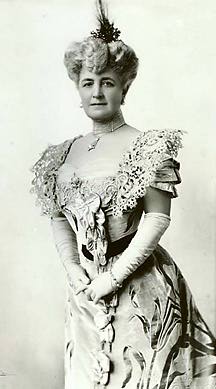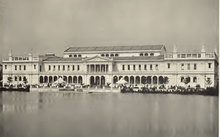Board of Lady Managers of the World's Columbian Exposition

The Board of Lady Managers of the World's Columbian Exposition was organized November 19, 1890.[1] It oversaw the construction of The Woman's Building in Chicago and organized the exposition's World's Congress of Representative Women (1893). A cookbook with autographed recipes of board members was also issued.
The Board of Lady Managers was created by the U.S. Congress to see that women were placed upon the Juries of Award, which were to pass upon work done wholly or in part by women, and to perform such other duties as might be assigned by the Exposition's National Commission. It was subsequently given by the Commission full management and control of the building known as the Woman's Building, together with the general charge and management of the interests of women in all of the Exposition buildings. It was made the official channel of communication through which all women or organizations of women were to be brought into relation with the Exposition, and through which applications for space for women or their exhibits should be received. The members of the Board succeeded in securing for women the fullest possible representation in the department buildings, and modified their original plans in order to increase the amount of space to be put at their disposal in the Woman's Building.[2]
Origins
Beginning in 1889, activist women in Chicago lobbied to make their city the site of the world's fair of 1892. They also petitioned for an official place for women in the planning and exhibitions at the fair. Led by Emma Gilson Wallace, they suggested forming a "Women's Department for the Fair".[3] These activists came from various women's organizations involved in philanthropy, education, and suffrage.[4]
The Quatro-Centennial Committee of the Senate (i.e. commemorating the 400th anniversary of Columbus's first voyage to the New World) approved the Fair Bill naming Chicago as the site. When the bill was sent to the House of Representatives, William McKendree Springer attached an amendment to create a Board of Lady Managers. The House accepted the bill and in 1890 President Benjamin Harrison signed the bill into law.[5]
The Board appointments, made by the National Commission, numbered 117, including two Lady Managers from each state, territory and the District of Columbia, as well as members-at-large.[6] Among their duties related to the Fair, the Lady Managers were in charge of the plans for the Women's Hall.
Administration

There were five convenings of the Board:
- First Session, November 19–26, 1890[7]
- Second Session, September 2–9, 1891[8]
- Third Session, October 1892[9]
- Fourth Session, April 1893[9]
- Fifth Session, July 1893[9]
The by-laws of the Board of Lady Managers, as amended, included provisions for an official title, quorum, powers of alternate managers, officers of the board, an executive committee, duties of the board president, duties of the board vice-presidents, duties of the board secretary, vice-chair of the executive committee, and amendments.[10]
The Woman's Building

Bertha Honoré Palmer served as the president of the 117-woman strong Board of Lady Managers, the organization which dealt with women's business at the World's Columbian Exposition.[11] The Board constructed The Woman's Building, designed by 21-year-old Sophia Hayden, as the showplace for women's art. The building itself was decorated by women artists, featuring architectural ornament sculpted by Enid Yandell and Alice Rideout, both 19, and a large painting by Mary Cassatt, Modern Woman, one of two extensive murals in the Woman's Building,[11] the other one, Primitive Woman being by Mary MacMonnies.[12] Interior art was curated by Candace Wheeler and Sara Hallowell.[11] The Board also built a Children's Building, a child-care center required to support fair-goers and convention-goers who brought children. As well, the Board built a women's dormitory near the fairgrounds, to house women traveling alone or with small children.[11]
Legacy
Carrie V. Shuman compiled a cookbook, Favorite Dishes: A Columbian Autograph Souvenir Cookery Book. Over three hundred autograph recipes, and twenty-three portraits, contributed specially by the Board of Lady Managers of the World's Columbia Exposition (Chicago, 1893) with illustrations by May Root-Kern, Mellie Ingels Julian, Louis Braunhold, and George Wharton Edwards.[13]
After the exposition, the Woman's Building was torn down, and the mural by Mary Cassatt was misplaced and lost. Bertha Palmer was appointed United States Commissioner at the Paris Exposition of 1900 by President William McKinley, the only woman so distinguished by any government.[14]
Notable people

Officers
Prominent officials:[15]
- Mrs. Bertha Palmer – President[16]
- Mrs. Susan G. Cook – Secretary
- Phoebe Couzins, Secretary[16]
- Mrs. V.C. Meredith – Vice Chairman Executive Committee
- Mrs. Russell B. Harrington – Vice-president at Large
- Mrs. John A. Logan – Vice-chairman Committee on Ceremonies
Vice-presidents:[17]
- Mrs. Ralph Trautman – First Vice-president
- Mrs. Edwin C. Burleigh – Second Vice-president
- Mrs. Charles Price – Third Vice-president
- Miss K.L. Minor – Fourth Vice-president
- Mrs. Beriah Wilkins – Fifth Vice-president
- Mrs. Susan R. Ashley – Sixth Vice-president
- Mrs. Flora Beall Ginty – Seventh Vice-president
- Mrs. Margaret Blaine Salisbury – Eighth Vice-president
Committee on Congresses
- Susan R. Ashley[18]
- Frances Elizabeth Newbury Bagley, Vice-chair[18]
- Helen Morton Barker [18]
- Laurette Lovell[18]
- Mary Kavanaugh Eagle , Chair[18]
- Eliza M. Russell[18]
- Julia Ball Reed Shattuck[18]
- Lillian M. N. Stevens[18]
Members
- Alice Barbee Castleman, Kentucky[19]
- Mary A. Cochran, Texas[20]
- Ellen M. Chandler, Vermont[20]
- Mrs. John Sergeant Wise, Virginia[20]
- Mrs. K. S. G. Paul, Virginia[20]
- Melissa D. Owings, Washington[20]
- Alice Houghton, Washington[20]
- Mrs. W. Newton Linch, West Virginia[20]
- Lily Irene Jackson, West Virginia[20]
- Flora Beall Ginty, Wisconsin[20]
- Mrs. William P. Lynde, Wisconsin[20]
- Mrs. F. H. Harrison, Wyoming[20]
- Frances E. Hale, Wyoming[20]
Resident members
- Helen Morton Barker[21]
- Mrs. Matilda B. Carse
- Dr. Frances Dickenson
- Mrs. James R. Doolittle, Jr.
- Mrs. James A. Mulligan
- Mrs. Potter Palmer
- Mrs. Leander Stone
- Mrs. L. Brace Shattuck
- Mrs. Solomon Thacher, Jr.
- Mrs. M.R.M. Wallace
Source:[22]
References
- ^ Board of Lady Managers 1891, p. 8.
- ^ Palmer 1894, pp. 159–60.
- ^ Weimann, Jeanne Madeline (1981). The Fair Women: the story of the Woman's Building World's Columbian Exposition Chicago 1893. Chicago: Academy Chicago. pp. 26-31. ISBN 0915864673.
- ^ Weimann, Jeanne Madeline (1981). The Fair Women: the story of the Woman's Building World's Columbian Exposition Chicago 1893. Chicago: Academy Chicago. pp. 27. ISBN 0915864673.
- ^ Weimann, Jeanne Madeline (1981). The Fair Women: the story of the Woman's Building World's Columbian Exposition Chicago 1893. Chicago: Academy Chicago. pp. 32-33. ISBN 0915864673.
- ^ Weimann, Jeanne Madeline (1981). The Fair Women: the story of the Woman's Building World's Columbian Exposition Chicago 1893. Chicago: Academy Chicago. pp. 40-42. ISBN 0915864673.
- ^ Eagle 1894, pp. 43–149.
- ^ Eagle 1894, pp. 151–312.
- ^ a b c Palmer 1894, pp. 90, 120, 142.
- ^ Eagle 1894, pp. 33–35.
- ^ a b c d Smith 2000, p. 354.
- ^ Weinmann, Jeanne Madeline, ‘’The Fair Women’’’, Academy Chicago, Chicago, Illinois, 1981 pp. 316-18
- ^ Shuman, Carrie V. (1893). Favorite Dishes: A Columbian Autograph Souvenir Cookery Book. Over Three Hundred Autograph Recipes, and Twenty-three Portraits, Contributed by the Board of Lady Managers of the World's Columbian Exposition. Illustrated by May Root-Kern, Mellie Ingels Julian, Louis Braunhold, George Wharton Edwards. R. R. Donnelley & sons Company, printers. Retrieved 27 November 2022.
- ^ Anthony 1902, p. 608.
- ^ Elliott, Maud Howe (1894). Art and Handicraft in the Woman's Building of the World's Columbian Exposition Chicago, 1983. Chicago and New York: Rand McNally & Company. p. 14.
- ^ a b "Board of Lady Managers · Women in the 1893 Columbian Exposition · Materiality and Spectacle 2015". ds-omeka.haverford.edu. Haverford College. Retrieved 27 November 2022.
- ^ Elliott, Maud Howe (1894). Art and Handicraft in the Woman's Building of the World's Columbian Exposition Chicago, 1983. Chicago and New York: Rand McNally & Company. p. 15.
- ^ a b c d e f g h Eagle 1894, p. 24.
- ^ Willard, Frances Elizabeth; Livermore, Mary Ashton Rice (1893). "CASTLEMAN, Mrs. Alice Barbee". A Woman of the Century: Fourteen Hundred-seventy Biographical Sketches Accompanied by Portraits of Leading American Women in All Walks of Life. Charles Wells Moulton. p. 161.
 This article incorporates text from this source, which is in the public domain.
This article incorporates text from this source, which is in the public domain.
- ^ a b c d e f g h i j k l Eagle 1894, p. 568.
- ^ Cherrington, Ernest Hurst (1925). Standard Encyclopedia of the Alcohol Problem. Vol. 1. American Issue Publishing Company. pp. 274–75. Retrieved 23 July 2022 – via Internet Archive.
 This article incorporates text from this source, which is in the public domain.
This article incorporates text from this source, which is in the public domain.
- ^ Weimann, Jeanne Madeline (1981). The Fair Women: the story of the Woman's Building World's Columbian Exposition Chicago 1893. Chicago: Academy Chicago. pp. 41. ISBN 0915864673.
Attribution
- Anthony, Susan B.; Harper, Ida Husted, editors. History of Woman Suffrage, Volume IV (1883–1900), published 1902, at Internet Archive
 This article incorporates text from this source, which is in the public domain: Board of Lady Managers (1891). Official manual of the Board of Lady Managers of the World's Columbian Commission : the minutes of the Board from the date of its organization, November 19, 1890, to the close of its second session, September 9, 1891, including the act of Congress and information in regard to the action of the World's Columbian Commission and of the Chicago directory of the Columbian Exposition. Chicago: Rand, McNally.
This article incorporates text from this source, which is in the public domain: Board of Lady Managers (1891). Official manual of the Board of Lady Managers of the World's Columbian Commission : the minutes of the Board from the date of its organization, November 19, 1890, to the close of its second session, September 9, 1891, including the act of Congress and information in regard to the action of the World's Columbian Commission and of the Chicago directory of the Columbian Exposition. Chicago: Rand, McNally. This article incorporates text from this source, which is in the public domain: Eagle, Mary Kavanaugh Oldham (1894). World's Congress of Representative Women (ed.). The Congress of women : held in the Woman's Building, World's Columbian Exposition, Chicago, U.S.A., 1893, with portraits, biographies and addresses. Chicago ; Philadelphia: International Pub. Co. Retrieved 27 November 2022.
This article incorporates text from this source, which is in the public domain: Eagle, Mary Kavanaugh Oldham (1894). World's Congress of Representative Women (ed.). The Congress of women : held in the Woman's Building, World's Columbian Exposition, Chicago, U.S.A., 1893, with portraits, biographies and addresses. Chicago ; Philadelphia: International Pub. Co. Retrieved 27 November 2022. This article incorporates text from this source, which is in the public domain: Palmer, Bertha Honoré (1894). Addresses and Reports of Mrs. Potter Palmer: President of the Board of Lady Managers, World's Columbian Commission. Rand, McNally. Retrieved 27 November 2022.
This article incorporates text from this source, which is in the public domain: Palmer, Bertha Honoré (1894). Addresses and Reports of Mrs. Potter Palmer: President of the Board of Lady Managers, World's Columbian Commission. Rand, McNally. Retrieved 27 November 2022.
Bibliography
- Smith, Karen Manners, author; Cott, Nancy F., editor. New Paths to Power, 1890–1920. Chapter 7 of No Small Courage, Oxford University Press, 2000, pp. 353–357. ISBN 0-19-513946-1
External links
- Appropriations for Board of Lady Managers World's Columbian Exposition: Letter from the Secretary of the Treasury, Transmitting, an Estimate of Appropriation, Submitted by the President of the World's Columbian Exposition, for Expenses of the Board of Lady Managers for the Fiscal Year Beginning July 1, 1893 (U.S. Government Printing Office, 1892)
